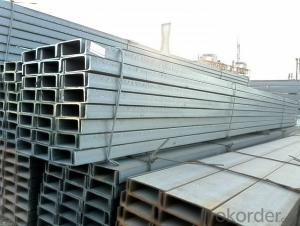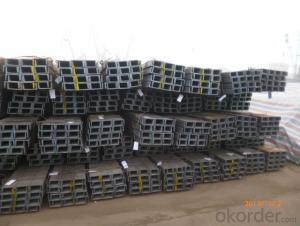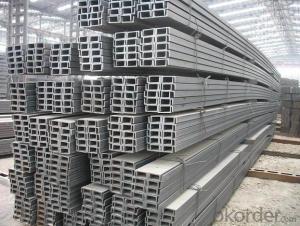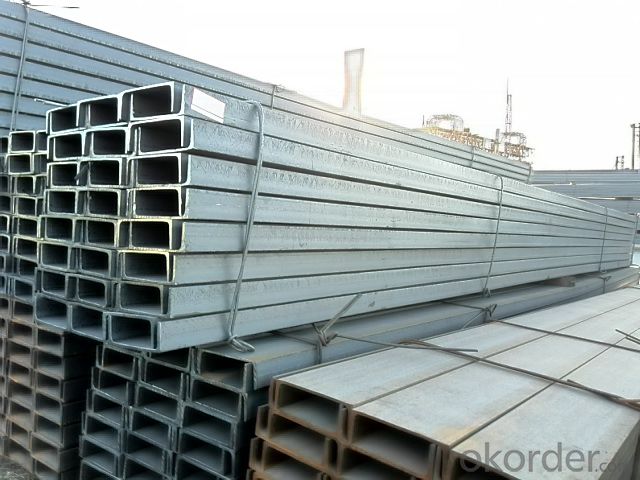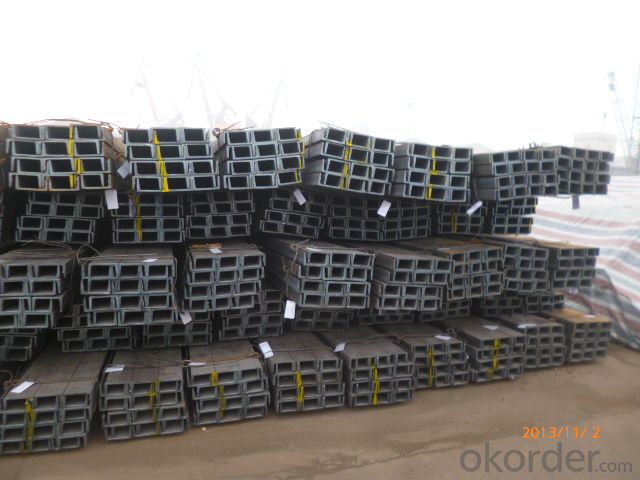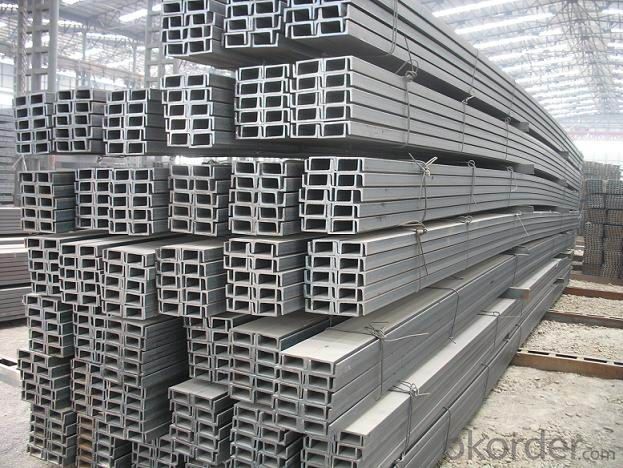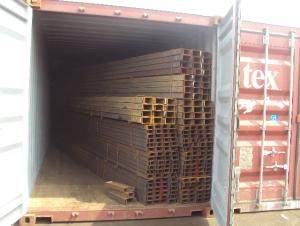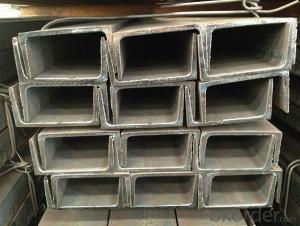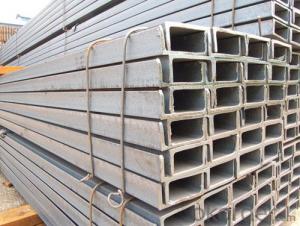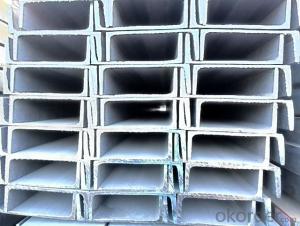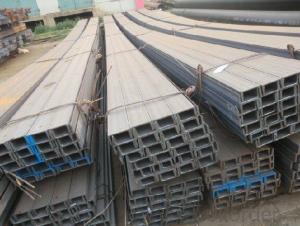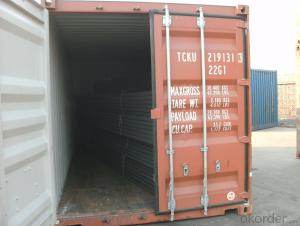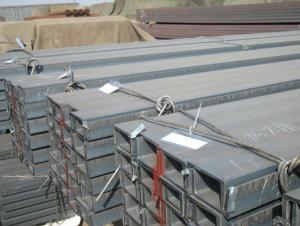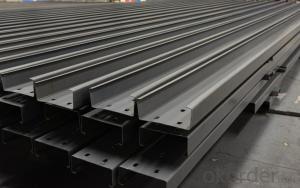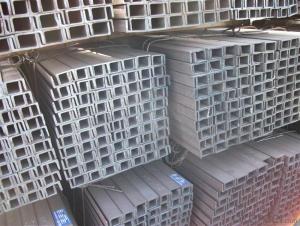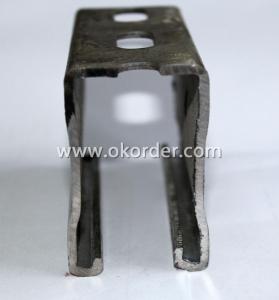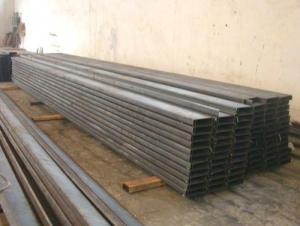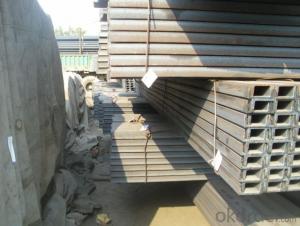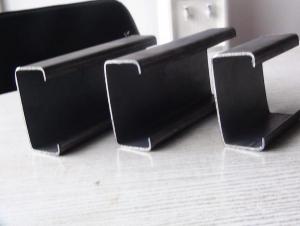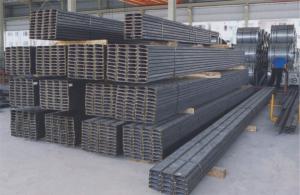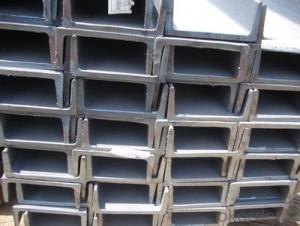Hot Rolled U-Channel from China Market with Best Quality
- Loading Port:
- Tianjin
- Payment Terms:
- TT OR LC
- Min Order Qty:
- 25 m.t
- Supply Capability:
- 10000 m.t/month
OKorder Service Pledge
OKorder Financial Service
You Might Also Like
Specification
OKorder is offering high quality Hot Rolled U-Channels at great prices with worldwide shipping. Our supplier is a world-class manufacturer of steel, with our products utilized the world over. OKorder annually supplies products to European, North American and Asian markets. We provide quotations within 24 hours of receiving an inquiry and guarantee competitive prices.
Product Applications:
The MS Channel can be applied to construction of warehouses, workshops, sport stadiums and car parks etc.The hot rolled channel steel belongs to carbon structural steel which is applied to in the field of construction and machinery.In details, the hot rolled channel steel is usually used for arch-itechtural structure, and they could be welded in order to support or hang a vari-ety of facilities. They are also usually used in combination with I beam. Generally,the hot rolled channel steel we supply must possess perfect welding property, riveting property and mechanical property and so on.
Product Advantages:
OKorder's Steel U-Channels are durable, strong, and resist corrosion.
Main Product Features:
· Premium quality
· Prompt delivery & seaworthy packing (30-45 days after receiving deposit)
· Corrosion resistance
· Can be recycled and reused
· Mill test certification
· Professional Service
· Competitive pricing
Product Specifications:
1.We supply high quality MS Channel at reasonable price, including Chinese standard, Japanese standard and so on.
Standard | GB/JIS |
Material Grade | Q235,SS400 |
Technique: | Hot Rolled |
Sizes as per chinese standard: | 50*37*4.5mm - 300*89*11.5mm |
Sizes as per japanese standard: | 50*25*3mm – 200*80*7.5mm |
Length: | 6meter, 9meter, 12meter |
Note: 1.we are also competent to provide our customers other MS Channel based on other sizes according to customer’s requirements.
2. The length of our ms channel could be cut into other meters as per customer’s requirements. For example, the channel in 6meters could be cut into 5.8meters in order to be fit in the 20ft container.
2. The detailed sections of MS Channel as per GB standard.are shown in the table-1:
GB U CHANNEL | Standard | Sectional | Dimension |
| Mass: |
(mm) | (mm) | (mm) | (mm) | ||
50X37 | 50 | 37 | 4.50 | 7.0 | 5.438 |
63X40 | 63 | 40 | 4.80 | 7.5 | 6.634 |
80x43 | 80 | 43 | 5.00 | 8.0 | 8.045 |
100x48 | 100 | 48 | 5.30 | 8.5 | 10.007 |
120x53 | 120 | 53 | 5.50 | 9.0 | 12.059 |
140x58 | 140 | 58 | 6.00 | 9.5 | 14.535 |
140x60 | 140 | 60 | 8.00 | 9.5 | 16.733 |
160x63 | 160 | 63 | 6.50 | 10.0 | 17.240 |
160x65 | 160 | 65 | 8.50 | 10.0 | 19.752 |
180x68 | 180 | 68 | 7.00 | 10.5 | 20.174 |
180x70 | 180 | 70 | 9.00 | 10.5 | 23.000 |
200x73 | 200 | 73 | 7.00 | 11.0 | 22.637 |
200x75 | 200 | 75 | 9.00 | 11.0 | 25.777 |
220x77 | 220 | 77 | 7.00 | 11.5 | 24.999 |
220x79 | 220 | 79 | 9.00 | 11.5 | 28.453 |
250x78 | 250 | 78 | 7.00 | 12.0 | 27.410 |
250x80 | 250 | 80 | 9.00 | 12.0 | 31.335 |
250x82 | 250 | 82 | 11.00 | 12.0 | 35.260 |
280x82 | 280 | 82 | 7.50 | 12.5 | 31.427 |
280x84 | 280 | 84 | 9.50 | 12.5 | 35.823 |
280x86 | 280 | 86 | 11.50 | 12.5 | 40.219 |
300x85 | 300 | 85 | 7.50 | 13.5 | 34.463 |
300x87 | 300 | 87 | 9.50 | 13.5 | 39.173 |
300x89 | 300 | 89 | 11.50 | 13.5 | 43.883 |
Table-1
FAQ:
Q1: Why buy Materials & Equipment from OKorder.com?
A1: All products are carefully selected from China's most reliable manufacturing enterprises. Through its ISO certifications, OKorder.com adheres to the highest standards and a commitment to supply chain safety and customer satisfaction. We can guarantee the quality!
Q2:What's your payment terms ?
A2: We can accept T/T,LC at sight and time LC.
Q3: Can you offer the third part inspection certificates ?
A3: We are able to present our customers relevant SGS test report for mechanical property of MS Channel as customer’s request.
Images:
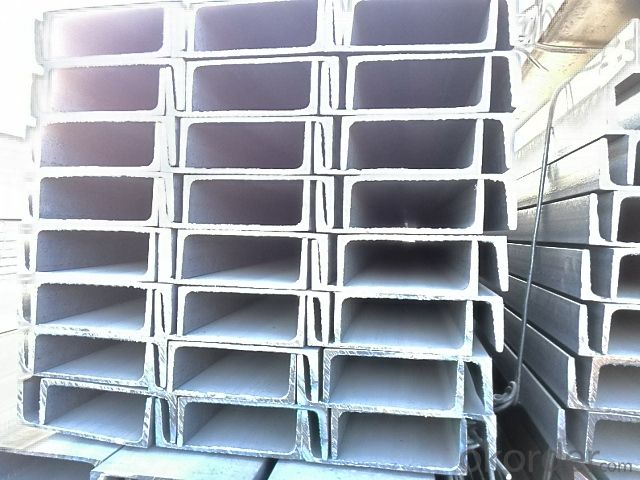
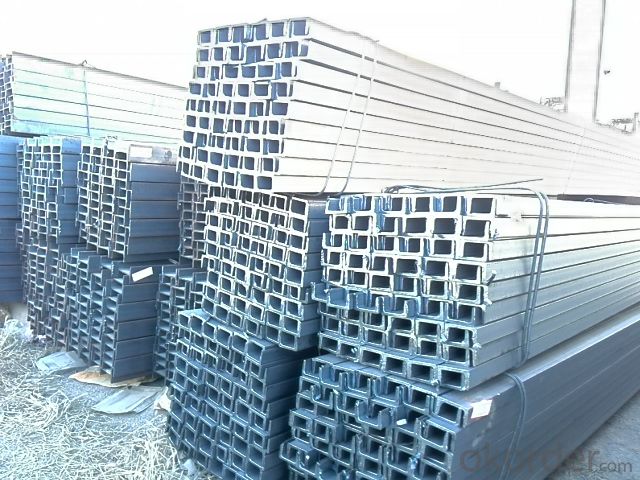
- Q: How do steel channels contribute to structural stability?
- Steel channels contribute to structural stability by providing additional support and reinforcement to the structure. These channels act as load-bearing elements that help distribute the weight and forces evenly, enhancing the overall strength and stability of the structure. They are commonly used in construction to resist bending, twisting, and other types of structural deformations, ultimately ensuring the safety and durability of the building or infrastructure.
- Q: Can steel channels be used for railway track support?
- Yes, steel channels can be used for railway track support. Steel channels are often used as a cost-effective and durable structural support element in various applications, including railway track support. They provide strength, stability, and load-bearing capacity, making them suitable for supporting the weight and forces exerted by trains on railway tracks. Steel channels can be easily fabricated and installed, and they have the ability to withstand harsh environmental conditions and heavy loads. Additionally, their inherent resistance to corrosion makes them a reliable choice for long-term use in railway track support systems.
- Q: How are steel channels protected against rust and corrosion?
- Steel channels can be protected against rust and corrosion through a variety of methods. One common method is through the use of coatings. These coatings can be applied to the surface of the steel channel to create a barrier between the metal and the surrounding environment. Examples of coatings include paint, epoxy, or galvanized coatings. Paint coatings provide a protective layer by preventing direct contact between the steel and oxygen, moisture, or other corrosive elements in the atmosphere. Epoxy coatings, on the other hand, are highly resistant to chemicals and provide excellent protection against corrosion. Galvanized coatings involve the application of a layer of zinc to the steel channel, which acts as a sacrificial layer, corroding in place of the steel. Another method to protect steel channels from rust and corrosion is through the process of electroplating. This involves the deposition of a thin layer of metal, such as zinc or chromium, onto the surface of the steel channel through an electrochemical process. The metal layer serves as a barrier against corrosive elements, preventing them from reaching the steel. Additionally, steel channels can be protected by using corrosion inhibitors. Corrosion inhibitors are chemicals that can be added to the environment surrounding the steel channel, such as in the form of coatings or through the use of inhibitors in the water used for cooling or other processes. These inhibitors work by forming a protective layer on the surface of the steel, preventing corrosion from occurring. Regular maintenance and cleaning are also important in preventing rust and corrosion on steel channels. Any accumulated dirt, dust, or other contaminants should be removed promptly, as they can trap moisture against the steel surface and accelerate corrosion. Inspecting the steel channels periodically and addressing any signs of damage or corrosion immediately can also help prevent further deterioration. Overall, a combination of coatings, electroplating, corrosion inhibitors, and proper maintenance practices can effectively protect steel channels against rust and corrosion, extending their lifespan and ensuring their structural integrity.
- Q: Are steel channels suitable for railway infrastructure?
- Yes, steel channels are suitable for railway infrastructure. Steel channels are commonly used in the construction of railway tracks and other infrastructure due to their strength, durability, and versatility. Steel channels provide structural support and stability, making them ideal for creating stable foundations for railway tracks. Additionally, steel channels have excellent load-bearing capabilities, allowing them to withstand the heavy weight and impact of trains passing over them. This makes them highly suitable for railway infrastructure as they can handle the constant stresses and strains imposed by moving trains. Moreover, steel channels are resistant to corrosion and weathering, which is crucial for railway infrastructure exposed to various environmental conditions. They can withstand extreme temperatures, moisture, and other external factors, ensuring a longer lifespan and reduced maintenance requirements. Furthermore, steel channels can be fabricated and installed in various shapes and sizes to meet the specific requirements of railway infrastructure. They can be easily customized to fit different track layouts, bridges, and other structures. This flexibility makes steel channels highly adaptable and suitable for a wide range of railway applications. Overall, steel channels offer numerous advantages, including strength, durability, corrosion resistance, and flexibility, which make them highly suitable for railway infrastructure. They provide the necessary support and stability, withstand heavy loads, and ensure long-term performance, making them a reliable choice for railway construction and maintenance.
- Q: Are steel channels suitable for use in the construction of machinery frames?
- The utilization of steel channels is widespread in the construction of machinery frames owing to their remarkable strength, durability, and versatility. These channels not only offer exceptional structural support but also have the ability to endure substantial loads, thus making them ideal for bearing the weight and various constituents of machinery. Moreover, steel channels permit flexibility in design, thereby enabling customization to fulfill specific requirements of the machinery frame. Furthermore, they possess resistance against corrosion and can withstand harsh environmental conditions, guaranteeing steadfast functionality and dependability in the long run. In conclusion, steel channels emerge as a dependable choice for the construction of machinery frames, providing stability, strength, and longevity.
- Q: Can steel channels be used for both residential and commercial construction?
- Yes, steel channels can be used for both residential and commercial construction. Steel channels are versatile structural components that can be used in various applications, including building frames, support beams, and in the construction of walls and ceilings. They provide strength and stability, making them suitable for both residential and commercial projects. Additionally, steel channels are durable, fire-resistant, and have a high load-bearing capacity, making them ideal for construction projects of different sizes and types.
- Q: What are the different methods of forming steel channels?
- There are several methods of forming steel channels, including hot rolling, cold rolling, extrusion, and press brake forming.
- Q: How are the types of I-beam and channel ABC distinguished? Tell me about it, please.
- According to the steel height, waist width, waist thickness to distinguish, C type thickness, thickness is thickest, weight is heaviest
- Q: Are steel channels suitable for use in bridges?
- Steel channels are well-suited for bridge construction due to a variety of reasons. Firstly, their high strength-to-weight ratio allows for the creation of lightweight yet resilient bridges. This is especially crucial in areas where weight restrictions exist. Moreover, steel channels possess exceptional resistance to corrosion, making them ideal for bridges that are exposed to harsh weather conditions. They are typically manufactured using corrosion-resistant alloys or coated with protective layers, ensuring the durability and longevity of the bridge structure. Furthermore, steel channels offer great flexibility in design and fabrication. They can be easily manipulated, cut, and welded to meet specific project requirements, enabling the construction of intricate bridge designs. Additionally, they can adapt to different load capacities, allowing engineers to build bridges that can accommodate varying traffic volumes and weights. Lastly, steel channels have a long and successful history in bridge construction. They have undergone rigorous testing and proven their ability to withstand heavy loads, extreme weather conditions, and provide long-term structural integrity. In conclusion, steel channels are a suitable option for bridges due to their high strength-to-weight ratio, resistance to corrosion, versatility in design, and established track record of performance.
- Q: What kind of channel is the best, there is an answer, if not, can come to a formula is OK?
- Wx:1. first calculate the cross-sectional area of the flange and web 2. respectively; find out the flange and web section of the center axis x1-x1, x2-x2; 3. were found the whole section X-X from the spindle flange and web section of the distance from the center of Y1, Y2, (Y1 for channel 0, x1-x1 is X-X; 4. spindle) are calculated respectively. The moment of inertia of flange and web sections of x1-x1, x2-x2, and the moment of inertia of flange part of the shift shaft to the spindle, X-X, flange and web can be obtained by adding the Ix section of the X-X moment of inertia; 5. Ix / H/2 is Wx.
Send your message to us
Hot Rolled U-Channel from China Market with Best Quality
- Loading Port:
- Tianjin
- Payment Terms:
- TT OR LC
- Min Order Qty:
- 25 m.t
- Supply Capability:
- 10000 m.t/month
OKorder Service Pledge
OKorder Financial Service
Similar products
Hot products
Hot Searches
Related keywords
